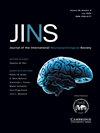特邀专题讨论会 2:脑图绘制需要高度个性化的方法:神经解剖学、生命周期和文化语言方面的考虑因素
IF 2.6
4区 心理学
Q2 CLINICAL NEUROLOGY
Journal of the International Neuropsychological Society
Pub Date : 2023-12-22
DOI:10.1017/s1355617723006525
引用次数: 0
摘要
&学习目标:脑图谱绘制对于降低癫痫和脑肿瘤手术中的认知发病风险至关重要。使用功能性核磁共振成像以及术外和术中电刺激进行脑图绘制,不仅需要高水平的功能性神经解剖学专业知识,还需要了解可能影响图绘制结果和术后效果的患者个体特征。患者在手术前的认知状态可能会有很大差异。疾病的神经解剖学、年龄和发育水平以及文化和语言差异都会影响患者在脑图谱绘制过程中的表现,并影响手术决策。本次会议的目的是讨论在脑图谱绘制过程中采取高度个性化方法的重要性,重点关注任务选择和数据解读中的解剖学考虑因素和患者个体差异。我们将介绍使用一种以上语言的患者的语言图谱。我们将提供实用信息,通过案例演示来帮助指导知情的任务选择,突出个性化脑图绘制的必要性:1.讨论基于皮层和皮层下功能神经解剖学的知情任务选择2.解释功能图谱如何随着正常发育而变化,以及在解释手术前规划结果时应考虑的因素3.评估双语和单语大脑之间的差异、调节双语者语言神经解剖表征的因素,以及绘制多语言图谱以进行手术规划的策略本文章由计算机程序翻译,如有差异,请以英文原文为准。
Invited Symposium 2: The Need for a Highly Individualized Approach to Brain Mapping: Neuroanatomical, Lifespan and Cultural-Language Considerations
& Learning Objectives:Brain mapping is critical in reducing risk for cognitive morbidity in epilepsy and brain tumor surgery. Mapping using functional MRI, and extra- and intraoperative electrical stimulation, requires a high level of expertise in functional neuroanatomy but also an understanding of individual patient characteristics that can impact mapping results and post-operative outcome. Patients can vary considerably with respect to their cognitive status going into surgery. The neuroanatomy of the disease, age and developmental level, and cultural and language differences can all influence patients' performance during brain mapping and impact surgical decision making. The purpose of this session is to discuss the importance of taking a highly individualized approach to brain mapping, focusing on anatomical considerations and individual patient differences in task selection and data interpretation. We will cover language mapping in patients who speak more than one language. Practical information will be provided to help guide informed task selection through illustrative case presentations that highlight the need for individualized brain mapping.Upon conclusion of this course, learners will be able to: 1. Discuss informed task selection based on cortical and subcortical functional neuroanatomy2. Explain how functional maps change with normal development and factors that should be considered when interpreting results for presurgical planning3. Assess differences between the bilingual and monolingual brain, factors that modulate the neuroanatomical representation of language in bilinguals and strategies in mapping multiple languages for surgical planning
求助全文
通过发布文献求助,成功后即可免费获取论文全文。
去求助
来源期刊
CiteScore
5.40
自引率
3.80%
发文量
185
审稿时长
4-8 weeks
期刊介绍:
The Journal of the International Neuropsychological Society is the official journal of the International Neuropsychological Society, an organization of over 4,500 international members from a variety of disciplines. The Journal of the International Neuropsychological Society welcomes original, creative, high quality research papers covering all areas of neuropsychology. The focus of articles may be primarily experimental, applied, or clinical. Contributions will broadly reflect the interest of all areas of neuropsychology, including but not limited to: development of cognitive processes, brain-behavior relationships, adult and pediatric neuropsychology, neurobehavioral syndromes (such as aphasia or apraxia), and the interfaces of neuropsychology with related areas such as behavioral neurology, neuropsychiatry, genetics, and cognitive neuroscience. Papers that utilize behavioral, neuroimaging, and electrophysiological measures are appropriate.
To assure maximum flexibility and to promote diverse mechanisms of scholarly communication, the following formats are available in addition to a Regular Research Article: Brief Communication is a shorter research article; Rapid Communication is intended for "fast breaking" new work that does not yet justify a full length article and is placed on a fast review track; Case Report is a theoretically important and unique case study; Critical Review and Short Review are thoughtful considerations of topics of importance to neuropsychology and include meta-analyses; Dialogue provides a forum for publishing two distinct positions on controversial issues in a point-counterpoint format; Special Issue and Special Section consist of several articles linked thematically; Letter to the Editor responds to recent articles published in the Journal of the International Neuropsychological Society; and Book Review, which is considered but is no longer solicited.

 求助内容:
求助内容: 应助结果提醒方式:
应助结果提醒方式:


